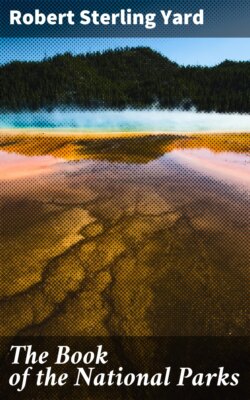Читать книгу The Book of the National Parks - Robert Sterling Yard - Страница 23
На сайте Литреса книга снята с продажи.
III
ОглавлениеEvery summer many thousands of visitors gather in Yosemite. Most of them, of course, come tourist-fashion, to glimpse it all in a day or two or three. A few thousands come for long enough to taste most of it, or really to see a little. Fewer, but still increasingly many, are those who come to live a little with Yosemite; among these we find the lovers of nature, the poets, the seers, the dreamers, and the students.
Living is very pleasant in the Yosemite. The freedom from storm during the long season, the dry warmth of the days and the coldness of the nights, the inspiration of the surroundings and the completeness of the equipment for the comfort of visitors make it extraordinary among mountain resorts. There is a hotel in the Valley, and another upon the rim at Glacier Point. There are three large hotel-camps in the Valley, where one may have hotel comforts under canvas at camp prices. Two of these hotel-camps possess swimming pools, dancing pavilions, tennis courts electrically lighted for night play, hot and cold-water tubs and showers, and excellent table service. One of the hotel-camps, the largest, provides evening lectures, song services, and a general atmosphere suggestive of Chatauqua. Still a third is for those who prefer quiet retirement and the tradition of old-fashioned camp life.
Above the valley rim, besides the excellent hotel upon Glacier Point, there are at this writing hotel-camps equipped with many hotel comforts, including baths, at such outlying points as Merced Lake and Tenaya Lake; the former centering the mountain climbing and trout fishing of the stupendous region on the southwest slope of the park, and the latter the key to the entire magnificent region of the Tuolumne. These camps are reached by mountain trail, Tenaya Lake Camp also by motor road. The hotel-camp system is planned for wide extension as growing demand warrants. There are also hotels outside park limits on the south and west which connect with the park roads and trails.
The roads, by the way, are fair. Three enter from the west, centering at Yosemite Village in the Valley; one from the south by way of the celebrated Mariposa Grove of giant sequoias; one from El Portal, terminus of the Yosemite Railway; and one from the north, by way of several smaller sequoia groves, connecting directly with the Tioga Road.
Above the valley rim and north of it, the Tioga Road crosses the national park and emerges at Mono Lake on the east, having crossed the Sierra over Tioga Pass on the park boundary. The Tioga Road, which was built in 1881, on the site of the Mono Trail, to connect a gold mine west of what has since become the national park with roads east of the Sierra, was purchased in 1915 by patriotic lovers of the Yosemite and given to the Government. The mine having soon failed, the road had been impassable for many years. Repaired with government money it has become the principal highway of the park and the key to its future development. The increase in motor travel to the Yosemite from all parts of the country which began the summer following the Great War, has made this gift one of growing importance. It affords a new route across the Sierra.
But hotels and hotel-camps, while accommodating the great majority of visitors, by no means shelter all. Those who camp out under their own canvas are likely to be Yosemite's most appreciative devotees. The camping-out colony lives in riverside groves in the upper reaches of the Valley, the Government assigning locations without charge. Many families make permanent summer homes here, storing equipment between seasons in the village. Others hire equipment complete, from tents to salt-cellars, on the spot. Some who come to the hotels finish the season under hired canvas, and next season come with their own. An increasing number come in cars, which they keep in local garages or park near their canvas homes.
Living is easy and not expensive in these camp homes. Midday temperatures are seasonable, and nights are always cool. As it does not rain, tents are concessions to habit; many prefer sleeping under the trees. Markets in the village supply meats, vegetables, milk, bread, and groceries at prices regulated by Government, and deliver them at your kitchen tent. Shops furnish all other reasonable needs. It is not camping out as commonly conceived; you are living at home on the banks of the Merced, under the morning shadow of Half Dome, and within sight of Yosemite Falls.
From these Valley homes one rides into the High Sierra on horses hired from the government concessioner, tours to the Tuolumne Meadows or the Mariposa Grove by automobile, wanders long summer afternoons in the Valley, climbs the great rocks and domes, picnics by moonlight under the shimmering falls or beneath the shining tower of El Capitan, explores famous fishing waters above the rim, and, on frivolous evenings, dances or looks at motion pictures at the greater hotel-camps.
No wonder that camp homes in the Yosemite are growing in popularity.
